TechEdSat
Technology Education Satellite (TechEdSat) is a class of CubeSats built by San Jose State University and University of Idaho students in partnership with NASA's Ames Research Center. These satellites have tested communication technology for smallsats, and have contributed to the development of the Small Payload Quick Return (SPQR) concept.
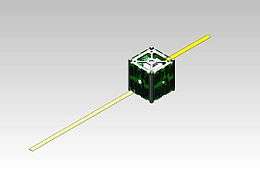 CAD drawing of TechEdSat-1 | |
| Mission type | Technology demonstration |
|---|---|
| Operator | San Jose State University · University of Idaho · JAXA · ÅAC Microtec · NASA |
| COSPAR ID | 1998-067CQ |
| SATCAT no. | 38854 |
| Start of mission | |
| Launch date | 21 July 2012, 02:06:00 |
| Rocket | H-II |
| Deployment date | 5 May 2013 |
| Orbital parameters | |
| Reference system | Geocentric |
| Regime | Low Earth |
| Perigee altitude | 402 kilometers (250 miles) |
| Apogee altitude | 422 kilometers (262 miles) |
| Inclination | 51.65 |
| Period | 92.80 minutes |
| Epoch | 9 October 2012 |
TechEdSat
The first TechEdSat (later renamed "TechEdSat-1" or "TES-1")[1][2][3] was a 1-U Cubesat designed to evaluate Space Plug-and-play Avionics (SPA) designed in Sweden by ÅAC Microtec. It was also originally intended to perform a communications experiment utilizing the Iridium and Orbcomm satellite phone network,[4] although this function was disabled before launch.[5] TechEdSat was deployed into orbit from the International Space Station on 4 Oct 2012. It reentered to atmosphere on 5 May 2013.[6]
NSSDCA ID: 2012-038D[7]
Hardware[8]
- Quake Global Q1000 Modem ( Orbcomm ) (Deactivated)
- Quake Global Q9602 Modem ( Iridium ) (Deactivated)
- Stensat Radio Beacon
- 4x nanoRTU (ÅAC Microtec)
- Main Power Distribution Board (ÅAC Microtec)
- RTU Lite (ÅAC Microtec)
- 2 meter band Monopole Antenna
- 70cm band Monopole Antenna
- 1600 MHz Patch Antenna
- Pumpkin, Inc. 1U Skeletonized CubeSat Structure
- Canon BP-930 Lithium-ion battery
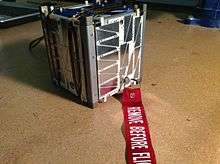

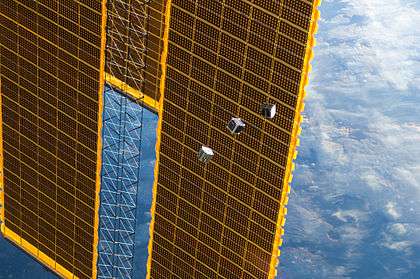
Specifications
- Dimensions: 113.5 mm x 100 mm x 100 mm
- Mass: 1.2 kg (2.6 lb)
- Power Consumption (Safe Mode): 0.35 W
- Power Consumption (Safe Mode, Stensat Transmitting): 3.4W
- Power Consumption (Nominal Mode): 3.965W
- Power Consumption (Q1000 Transmitting): 27.125W
- Power Consumption (Q9602 Transmitting): 10.49W
- Power Consumption (Nominal Mode, Stensat Transmitting): 7.015W
- Solar Array (Average): 1.229W
- Power Storage: 17 Wh
Launch
TechEdSat was launched from Pad 2 of the Tanegashima Yoshinobu Launch Complex on 21 July 2012, at 02:06 UTC,[9] aboard Kounotori 3 atop an H-IIB launch vehicle. Kounotori 3 carried the satellite, along with the Raiko, We-Wish, Niwaka, and F-1 spacecraft, to the International Space Station, from where it was deployed via the JAXA J-SSOD deployer, from the Kibo module on 4 Oct 2012 at 15:44:15.297 UTC.[10]
Beacon Packet Format
TechEdSat-1 transmitted a heartbeat packet over amateur radio every 4 seconds. These packets are 122 ASCII character AX.25 packets. Amateur band radio frequency is 437.465 MHz.[11]
Two consecutive 12 bit raw ADC Data values are parsed into one 3 byte chunk in order to save data space.
TechEdSat-2
TechEdSat-2 was planned as a 6U CubeSat, a collaboration between ÅAC Microtec in Sweden and NASA Ames.[12]
An Iridium transceiver flew aboard the PhoneSat v1b CubeSat as the TechEdSat-2 mission, separate from the spacecraft originally planned as TechEdSat-2.[13]
PhoneSat v1b (TES-2) SATCAT no.: 39142
PhoneSat v1b (TES-2) COSPAR ID: 2013-016A
PhoneSat v1b (TES-2) NSSDCA ID: 2013-016A[7]
PhoneSat v1b (TES-2) Orbital Parameters:[14]
- Perigee: 218 kilometres (255 mi)
- Apogee: 228 kilometres (258 mi)
- Inclination: 51.64 degrees
- Period: 88.95 minutes
- Epoch: 24 April 2013
TechEdSat-3p
| Mission type | Technology demonstration |
|---|---|
| Operator | San Jose State University · University of Idaho · NASA |
| COSPAR ID | 1998-067DD |
| SATCAT no. | 39415 |
| Start of mission | |
| Launch date | 3 August 2013, 19:48:46 UTC |
| Rocket | H-IIB |
| Launch site | Tanegashima Space Center |
| Orbital parameters | |
| Reference system | Geocentric |
| Regime | Low Earth |
| Perigee altitude | 410 kilometers (255 miles) |
| Apogee altitude | 415 kilometers (258 miles) |
| Inclination | 51.65 |
| Period | 92.81 minutes |
| Epoch | 20 November 2013 |
TechEdSat-3p was the third spacecraft flown in the TechEdSat series. Its dimensions were approximately 30*10*10 cm, or three CubeSat units long, making it three times larger than TechEdSat-1. TechEdSat-3p was launched to the International Space Station on 20 November 2013 from Tanegashima, Japan on the HTV-4 International Space Station cargo resupply mission and subsequently deployed into orbit by the JEM-Small Satellite Orbital Deployer.
TechEdSat-3p was the first satellite of the TechEdSat series to include an exo-brake, a parachute-like drag device to demonstrate passive deorbit capability.[15] The deployment of an exo-brake increases the surface area of a satellite, increasing its coefficient of drag in the thin upper atmosphere and causing the satellite to deorbit faster than it otherwise would. This technology could be used to more quickly dispose of satellites in Low Earth Orbit that have completed their missions, decreasing the amount of potentially hazardous debris in space. The exo-brake is currently being developed for use as part of the Small Payload Quick Return concept, which would enable science materials to be returned to Earth from the International Space Station whenever is most convenient for scientists rather than just a few times per year aboard a returning cargo resupply vehicle.
According to smallsat logistics company ÅAC Microtech, a main power distribution board designed for TechEdSat-1 was reused on the TechEdSat-3p mission.[16]
NSSDCA ID: TECHEDS3P[7]
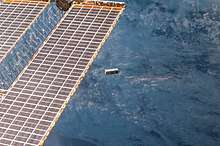
TechEdSat-4
| Mission type | Technology demonstration |
|---|---|
| Operator | San Jose State University · University of Idaho · NASA |
| COSPAR ID | 1998-067FY |
| SATCAT no. | 40455 |
| Start of mission | |
| Launch date | 13 July 2014 |
| Rocket | Antares-120 |
| Launch site | Mid-Atlantic Regional Spaceport |
| Deployment date | 4 March 2015 |
| Orbital parameters | |
| Reference system | Geocentric |
| Regime | Low Earth |
| Perigee altitude | 393 kilometers (244 miles) |
| Apogee altitude | 402 kilometers (250 miles) |
| Inclination | 51.64 |
| Period | 92.50 minutes |
| Epoch | 5 March 2015 |
TechEdSat-4 was a 3U CubeSat mission developed, integrated, and tested at NASA Ames in partnership with student interns from San Jose State University in California and the University of Idaho in Moscow, Idaho. The objective of the TechEdSat-4 mission was to demonstrate new technologies including satellite-to-satellite communications and an upgraded Exo-Brake device to demonstrate a passive deorbiting. TechEdSat-4 was launched as a secondary cargo payload on the Cygnus CRS Orb-2 ISS resupply mission. The launch vehicle was the Orbital Sciences Corporation Antares-120, launching from the Mid-Atlantic Regional Spaceport on Wallops Island, VA on 13 July 2014.[17] TechEdSat-4 was deployed from the International Space Station via the NanoRacks CubeSat Deployer on 4 March 2015.[18][19]
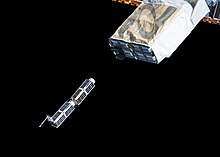
TechEdSat-5
| Mission type | Technology demonstration |
|---|---|
| Operator | San Jose State University · University of Idaho · NASA |
| COSPAR ID | 1998-067LB |
| SATCAT no. | 42066 |
| Start of mission | |
| Launch date | 9 December 2016 |
| Rocket | H-II |
| Launch site | Tanegashima Space Center |
| Deployment date | 6 March 2017, 18:20 UTC |
| Orbital parameters | |
| Reference system | Geocentric |
| Regime | Low Earth |
| Perigee altitude | 397 kilometers (247 miles) |
| Apogee altitude | 408 kilometers (254 miles) |
| Inclination | 51.64 |
| Period | 92.61 minutes |
| Epoch | 8 March 2017 |
TechEdSat-5 was a 4 kg, 3.5U CubeSat that was launched on 9 December 2016 aboard the HTV-6 cargo resupply spacecraft, and was deployed from the International Space Station at 18:20 UTC on 6 March 2017.[20] It was the first satellite in the TechEdSat program to include a modulated Exo-Brake that was could adjust the amount of atmospheric drag on the spacecraft, enabling a targeted re-entry.[21] The TechEdSat-5 Exo-Brake was cross-shaped, made of mylar, and used a combination of mechanical struts and flexible cords.[22] Its surface area was approximately 0.35 square metres.[20] A ‘Cricket’ Wireless Sensor Module (WSM) was included with TechEdSat-5.[23] The satellite reentered the atmosphere on July 29, 2017 after successfully operating for 144 days.[22]
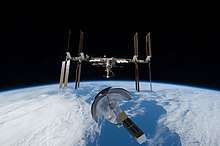
TechEdSat-6
| Mission type | Technology demonstration |
|---|---|
| Operator | San Jose State University · University of Idaho · NASA |
| COSPAR ID | 1998-067NK |
| SATCAT no. | 43026 |
| Start of mission | |
| Launch date | 12 November 2017, 12:19:51 |
| Rocket | Antares 230 |
| Launch site | Mid-Atlantic Regional Spaceport |
| Deployment date | 20 November 2017 |
| Orbital parameters | |
| Reference system | Geocentric |
| Regime | Low Earth |
| Perigee altitude | 397 kilometers (247 miles) |
| Apogee altitude | 406 kilometers (252 miles) |
| Inclination | 51.65 |
| Period | 92.59 minutes |
| Epoch | 21 November 2017 |
TechEdSat-6 was a CubeSat that was launched at 12:19 UTC on 12 November 2017 aboard the Cygnus CRS-8 cargo resupply mission to the International Space Station.[24][25] It was deployed from the NanoRacks Nanolauncher on 20 November 2017.[26] In addition to the primary payload, it contained a CubeSat Identity Tag (CUBIT), a Radio Frequency Identification (RFID) tag developed by DARPA and SRI International to assist in future identification of satellites. It successfully reentered the atmosphere on 14 May 2018.[27]
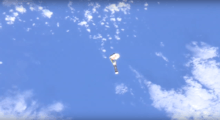
TechEdSat-7
TechEdSat-7 is a 2U CubeSat that is intended to test a High Packing Density Exo-Brake. It is planned to launch on Virgin Orbit's LauncherOne as part of NASA's ELaNa program. It will fly with a CubeSat Identity Tag (CUBIT), a Radio Frequency Identification (RFID) tag developed by DARPA and SRI International to assist in future identification of satellites.[28]
Operators: SJSU, NASA Ames Research Center
TechEdSat-8
| Mission type | Technology demonstration |
|---|---|
| Operator | San Jose State University · NASA |
| COSPAR ID | 1998-067PY |
| SATCAT no. | 44032 |
| Start of mission | |
| Launch date | 5 December 2018, 18:16:00 |
| Rocket | Falcon 9 |
| Deployment date | 31 January 2019 |
| End of mission | |
| Decay date | 20 April 2020 |
| Orbital parameters | |
| Reference system | Geocentric |
| Regime | Low Earth |
| Eccentricity | 0.0005 |
| Perigee altitude | 402 kilometers (250 miles) |
| Apogee altitude | 409 kilometers (254 miles) |
| Inclination | 51.64 |
| Period | 92.67 minutes |
| Epoch | 31 January 2018 |
TechEdSat-8 was a 6 unit CubeSat that included an exo-brake designed for continued operation in high temperature environments. This technology, known as a "Hot Exo-Brake" could enable more precisely-targeted atmospheric reentries. An ablation device was also flying on the spacecraft. TechEdSat-8 was originally planned to launch with the Cygnus NG-10 cargo resupply mission to the International Space Station as part of the ELaNa program, but instead launched aboard the SpaceX CRS-16 ISS cargo resupply mission at 18:16 UTC on 5 December,[29] arriving at the ISS on 8 December 2018.[30][31] TechEdSat-8 was deployed into orbit by the JEM-Small Satellite Orbital Deployer at 16:45 UTC on 31 January 2019.[32] The satellite established communication with controllers and, as of 20 February 2019, was reportedly performing well in advance of a targeted reentry.[33] The satellite failed shortly after launch due to a loss of power from its solar panels, and re-entered Earth's atmosphere on 20 April 2020.[34][35]
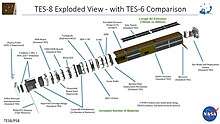
TechEdSat-10
TechEdSat-10 is a 6U (previously planned as 3U) CubeSat that was selected in 2018 to launch as part of the ELaNa program.[36] On 15 February 2020, TechEdSat-10 was launched to the ISS aboard the Cygnus NG-13 cargo spacecraft.[37] Deployed on 13 July 2020, TechEdSat-10 will test radio communication devices, precision deorbit technologies for NOAA and others, radiation tolerant electronics, and artificial intelligence hardware for future experiments.[38][34][37]
Future TechEdSats
TechEdSat-9 and TechEdSat-11 are planned to fly at some point in the future.[39] TechEdSat-9, like TechEdSat-10, is planned to test radio communication technologies for NOAA and others.[34]
TechEdSat-12 will test technologies for the tracking and identification of small satellites. It will carry a radio-frequency identificaition (RFID) tag, a radar reflector, and an L-band antenna. It was selected for launch in February 2020 by NASA's CubeSat Launch Initiative, and will be delivered to orbit on a launch contracted through the ELaNa program.[40]
References
- http://space.skyrocket.de/doc_sdat/techedsat.htm
- https://www.nasa.gov/sites/default/files/atoms/files/techedsat5-factsheet-508-april2017.pdf
- https://web.archive.org/web/20161229151730/https://solarsystem.nasa.gov/docs/1_04_An%20Overview%20of%20the%20SOAREX%20and%20TechEdSat%20Flight%20Series_M.S.%20Murbach.pdf
- Gunter Dirk Krebs (January 31, 2012). "TechEdSat". Gunter's Space Page. Retrieved February 1, 2012.
- AmSat, "TechEdSat to Use Satphone":
The plan to transmit from space using frequencies allocated to Iridium and Orbcomm SatPhone ground stations has been canceled. A statement from the team says: “We were forced to disable the Iridium modem as our FCC license did not come in time. As usual, building the satellite is the easy part.”
(accessed 12 Sept 2014) - TechEdSat Twitter
- "NASA - NSSDCA - Master Catalog". nssdc.gsfc.nasa.gov. Retrieved 2018-09-09.
- TechEdSat specifications (accessed 12 Sept 2014)
- "Japanese H-IIB launches HTV-3 to the International Space Station – NASASpaceFlight.com". www.nasaspaceflight.com. Retrieved 2018-09-08.
- "CubeSat Orbital Elements". Archived from the original on December 19, 2012. Retrieved October 4, 2012.
- "TechEdSat". IARU. April 3, 2012. Retrieved April 6, 2012.
- Gunter's Space Page, TechEdSat 2 (TES 2) (accessed 12 Sept 2014)
- "PhoneSat 1.0". space.skyrocket.de. Retrieved 2018-09-08.
- McDowell, Jonathan. "Satellite Catalog". Jonathan's Space Page. Retrieved 8 September 2018.
- TechEdSat 3 (accessed 12 Sept 2014)
- "Case". ÅAC Microtec. Retrieved 2019-01-31.
- TechEdSat-4 (Technological and Educational Nanosatellite-4) (accessed 12 Sept 2014)
- The Development of On-Demand Sample Return Capability (SPQR) (TechEdSat-4) - 05.24.17
- TechEdSat-4 (Technological and Educational Nanosatellite-4)
- "Re-Entry: TechEdSat-5 – Spaceflight101". spaceflight101.com. Retrieved 2018-09-09.
- "TechEdSat 5 (TES 5)". space.skyrocket.de. Retrieved 2018-09-08.
- "TechEdSat5 - eoPortal Directory - Satellite Missions". directory.eoportal.org. Retrieved 2018-09-08.
- Minafra, Kimberly (2017-03-06). "NASA Tests Braking Device for Returning Small Spacecraft from Space". NASA. Retrieved 2018-09-09.
- "Cygnus "S.S. Gene Cernan" En-Route to Space Station after Sunday Morning Commute to Orbit – Spaceflight101". spaceflight101.com. Retrieved 2018-09-09.
- Phillips, Veronica (2017-11-10). "About TechEdSat". NASA. Retrieved 2018-09-08.
- Minafra, Kimberly (2017-11-09). "NASA to Test Wireless Network and Device for Returning Smallsats". NASA. Retrieved 2018-09-08.
- Albaugh, Astrid (2018-06-01). "Ames Astrogram - June 2018". NASA. Retrieved 2018-10-31.
- "TechEdSat 7 (TES 7)". space.skyrocket.de. Retrieved 2018-09-08.
- "Dragon Launch Slips One Day as New Crew Moves In – Space Station". blogs.nasa.gov. Retrieved 2018-12-26.
- "Dragon Attached to Station, Returns to Earth in January – Space Station". blogs.nasa.gov. Retrieved 2018-12-26.
- "Space station receives second of back-to-back cargo deliveries – Spaceflight Now". spaceflightnow.com. Retrieved 2018-11-26.
- NanoRacks (2019-01-31). "And, that's a wrap! After an early wake up call this morning, the last #CubeSat deployment from our 15th mission on @Space_Station is now complete! #TechEdSat8 was released at 16:45 GMT/10:45 CST. Congratulations to the teams at @NASAAmes and @SJSU - another huge success!pic.twitter.com/ZKqLrnoreQ". @NanoRacks. Retrieved 2019-01-31.
- Clark, Stephen. "CubeSat deployed from space station to test sample return technology – Spaceflight Now". Retrieved 2019-02-20.
- Backus, Beau (24 April 2019). "Report and Status of the Small Satellite DCS Use Concept Validation Project" (PDF). Retrieved 10 May 2020.
- McDowell, Jonathan (2020-04-23). "The @techedsat #Techedsat 8 satellite reentered on Apr 20. It Unfortunately there's no TIP message to give an accurate reentry time: I hope @NASAAmes @SJSU Marc Murbach et al ( maybe @Ali_AKZAYAKATL ?) will tell us how the controlled entry attempt went". @planet4589. Retrieved 2020-05-10.
- Krebs, Gunter (2020-02-20). "TechEdSat 10 (TES 10)". Gunter's Space Page. Retrieved 2020-05-17.
- Clark, Stephen (2020-02-18). "Cygnus freighter delivers new British-made antenna to International Space Station". Spaceflight Now. Retrieved 2020-05-17.
- Hill, Denise (2020-07-13). "CubeSat Launch Initiative Deploys 109th CubeSat". NASA. Retrieved 2020-07-17.
- "Students at SJSU collaborate with NASA to launch a satellite into space". mercurynews.com. Retrieved 2019-01-31.
- Hill, Denise (2020-02-21). "NASA Announces Next Round of Candidates for CubeSat Space Missions". NASA. Retrieved 2020-02-21.